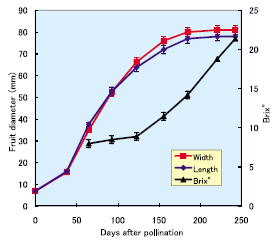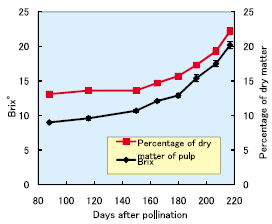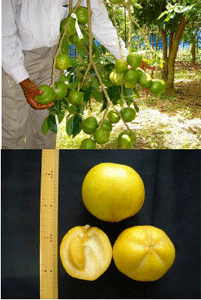An index for maturity and harvesting time of white sapote
Description
White sapote (Casimiroa edulis Llave & Lex.) is an evergreen subtropical fruit tree belonging to Rutaceae, native to the highlands of Mexico and Central America. Its fruit has a sweet taste and low acidity, suitable for consumption as fresh fruit. The flavor can be preserved for long periods under refrigerated conditions. Furthermore, it is thought to be a promising new fruit crop for commercial cultivation due to its high yield (Fig. 4 top) and easy maintenance. However, there are few commercial white sapote orchards due to the short shelf-life of the fruit after ripening and the difficulty in determining the optimum harvesting time by visual observation because the fruit skin color does not change much at maturity. Harvesting immature fruit leads to low sugar content and consumer dissatisfaction. There is a slight bitterness in the fruit of most white sapote cultivars, and this may also lead to consumer discontent. It is therefore important to clarify what is a suitable harvesting time and establish a practical index to determine harvesting time for white sapote to increase its popularity.
Experiments were performed in 2003 and 2004 using the same five 7-year-old white sapote trees of cv. “Cuccio” grown under conventional commercial conditions in a field in Okinawa, Japan. The fruits showed a sigmoid growth pattern for fruit width and length (Fig. 1). The growth rate decreased 185 days after pollination (DAP). The TSS content (Brix) of the fruit pulp increased rapidly from 120 DAP, reaching 18~20o Brix at 220 DAP (Figs. 1 and 2). The percentage of dry matter (DM) in the fruit pulp increased with increased Brix during the fruit’s development (Fig. 2). There is a strong correlation between TSS content and percentage DM in pulp; therefore, %DM > 18.0% could be used as an index for fruit maturity. The rapid increase in Brix in the late period of fruit development is thought to be due to increased translocation of substances from the leaves rather than decomposition of starch, since the starch content in the fruit at this period is low (Fig. 3) at less than 1.5%, and little sugar is produced from the starch during the ripening period (Fig. 3). Thus it is necessary to harvest the fruit after the sugar content becomes high enough for fresh fruit consumption. The bitter polyphenol (equivalent to catechin) content in the fruit pulp is about 3% of DM at 88 DAP, falling to below 1% at 207 DAP, then remaining constant. This suggests that cv. “Cuccio” should be harvested 207 DAP to minimize the bitterness. Even though the fruit skin color changes little on the tree, it turns to yellowish when the fruit softens after ripening (Fig. 4 bottom).
These results indicate that DAP, TSS, and % DM are potentially good indicators of fruit maturity in cv. “Cuccio.”
Figure, table
-
Fig. 1. Changes in fruit diameter (width and length) and total soluble solids (TSS) content during fruit development in white sapote cv. “Cuccio” (2003). -
Fig. 2. Changes in dry matter percentage and total soluble solid (TSS) content during fruit development in white sapote cv. ‘Cuccio’ (2004). -
Fig. 3. Changes in polyphenol and starch contents during fruit development in white sapote cv. “Cuccio” (2004). -
Fig. 4. Fruit set on branch (above). Fruit after ripening (below).
- Affiliation
-
Japan International Research Center for Agricultural Sciences Tropical Agriculture Research Front
- Classification
-
Technical A
- Term of research
-
FY2006(FY2006~2010)
- Responsible researcher
-
YONEMOTO Yoshimi ( Tropical Agriculture Research Front )
NOMURA Keiichi ( Kobe University )
IDE Mai ( Kobe University )
INOUE Hirotsugu ( Okinawa Prefectural Agricultural Research Center )
MAJIKINA Mayumi ( Okinawa Prefectural Agricultural Research Center )
OKUDA Hitoshi ( Mie University )
- ほか
- Publication, etc.
-
Y. Yonemoto, K. Nomura, M. Ide, H. Inoue, M. Majikina and H. Okuda (2006): Index for harvesting time of white sapote (Casimiroa edulis Llave & Lex.) cv. ‘Cuccio’. Journal of Horticultural Science & Biotechnology 81: 18-22.
- Japanese PDF
-
2006_seikajouhou_A4_ja_Part25.pdf689.32 KB



